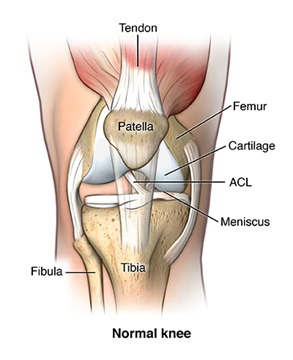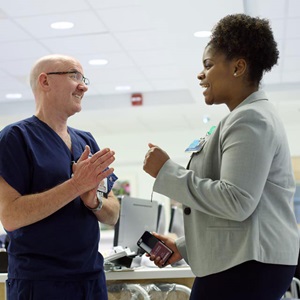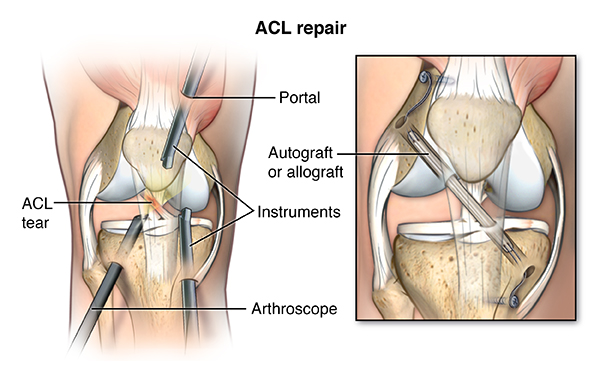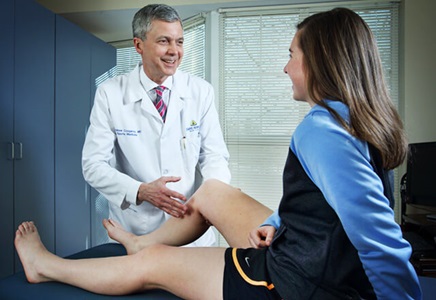How To Repair A Rosco Knee Scotter
Genu Ligament Repair
What is knee ligament repair?
Ligaments are bands of tough, elastic connective tissue that environs a joint to requite support and limit the joint's move.
When ligaments are damaged, the genu joint may become unstable. Ligament damage often happens from a sports injury. A torn ligament severely limits knee movement. This results in the disability to pivot, turn, or twist the leg. Surgery is a choice to repair a torn ligament if other medical treatment is non effective.

There are 4 major ligaments in the human knee. The ligaments in the genu connect the femur (thighbone) to the tibia (shin bone), and include the post-obit:
- Anterior cruciate ligament (ACL). The ligament, located in the center of the knee joint, that controls rotation and frontward move of the tibia (shin bone).
- Posterior cruciate ligament (PCL). The ligament, located in the eye of the knee, that controls astern motion of the tibia (shin os).
- Medial collateral ligament (MCL). The ligament that gives stability to the inner knee.
- Lateral collateral ligament (LCL). The ligament that gives stability to the outer human knee.

ACL Tears in Female Athletes: Q&A with a Sports Medicine Expert
Sports injury prevention isn't a one-stop shop, especially for injuries like ACL tears, which are 4 to 8 times more than mutual amongst women than men. Discover ways for women to help preclude this common injury.
Why might I need a human knee ligament repair?
The inductive cruciate ligament (ACL) is located toward the forepart of the knee. It is the most common ligament to exist injured. The ACL is often stretched and/or torn during a sudden twisting motion (when the feet stay planted one mode, but the knees turn the other way). Skiing, basketball, and football are sports that have a college take a chance of ACL injuries.
The posterior cruciate ligament (PCL) is located toward the back of the knee. It is also a common genu ligament to be injured. All the same, the PCL injury normally happens with sudden, direct impact, such equally in a car blow or during a football tackle.
The medial collateral ligament (MCL) is located on the inner side of the knee. It is injured more than often than the lateral collateral ligament (LCL), which is on the outer side of the knee. Stretch and tear injuries to the collateral ligaments are commonly caused past a blow to the outer side of the knee, such every bit when playing hockey or football.
Early medical treatment for knee ligament injury may include:
-
Rest
-
Ice pack application (to reduce swelling that happens within hours of the injury)
-
Compression (from an elastic bandage or brace)
-
Height
-
Pain relievers
A knee ligament tear may exist treated with the post-obit:
-
Musculus-strengthening exercises
-
Protective articulatio genus brace (for use during exercise)
-
Activity limitations
Knee ligament repair is a treatment for a complete tear of a knee ligament that results in instability in the human knee. People with a torn articulatio genus ligament may be unable to do normal activities that involve twisting or turning at the human knee. The knee may buckle or "give-mode." If medical treatments are not satisfactory, ligament repair surgery may exist an effective treatment.
The surgery to correct a torn human knee ligament involves replacing the ligament with a piece of healthy tendon. A tendon from the kneecap or hamstring, for example, is grafted into place to concord the knee joint together. The tendon graft may come from the person (autograft) or from an organ donor (allograft).
There may be other reasons for your healthcare provider to recommend a genu ligament repair.
ACL Injuries | Q&A with Dr. Jay Lee
What are the risks of knee ligament repair?
As with any surgical procedure, complications can happen. Some possible complications may include the following:
-
Bleeding
-
Infection
-
Blood clots in the legs or lungs
Some people may feel pain, limited range of motion in the knee joint joint, and occasional swelling in the knee later surgical ligament repair. Others have increased move in the knee joint as the graft stretches over time.
There may be other risks depending on your specific medical condition. Be sure to discuss whatever concerns with your healthcare provider earlier the procedure.
Preparing for Knee Replacement Surgery | Q&A with Savya Thakkar, M.D.
Orthopaedic hip and knee surgeon Savya Thakkar describes how to prepare for your knee replacement surgery, the process, recovery and life with an implant.
How do I go ready for a knee ligament repair?
-
Your healthcare provider will explain the process to you and offering you the chance to ask whatever questions that you lot might have about the procedure.
-
You will be asked to sign a consent course that gives your permission to do the process. Read the course advisedly and inquire questions if something is not articulate.
-
In addition to a consummate medical history, your healthcare provider may perform a complete physical exam to ensure you are in good health before undergoing the procedure. You may undergo blood tests or other diagnostic tests.
-
Tell your healthcare provider if you are sensitive to or are allergic to any medicines, latex, record, and anesthetic agents (local and general).
-
Tell your healthcare provider of all medicines (prescribed and over-the-counter) and herbal supplements that yous are taking.
-
Tell your healthcare provider if you lot have a history of bleeding disorders or if y'all are taking whatever anticoagulant (blood-thinning) medicines, aspirin, or other medicines that affect blood clotting. Information technology may be necessary for you to stop these medicines before the process.
-
If you are pregnant or suspect that yous are pregnant, you should notify your healthcare provider.
-
You will exist asked to fast for 8 hours before the procedure, generally after midnight.
-
You may receive a sedative prior to the procedure to assistance yous relax. Considering the allaying may make you lot drowsy, you will need to arrange for some to drive y'all domicile.
-
Yous may see with a physical therapist prior to your surgery to discuss rehabilitation.
-
Arrange for someone to assist around the house for a week or 2 subsequently you are discharged from the infirmary.
-
Based on your medical condition, your healthcare provider may request other specific grooming.

Your thoughts thing to us. Join our customs today.
Johns Hopkins Medicine Virtual Advisors (Virtual Advisors) is a group of individuals who share their insights about the Johns Hopkins intendance feel. Ane to 2 times per month, Virtual Advisors receive a link to short, interactive surveys. All responses are confidential.
What happens during a knee ligament repair?
Knee ligament repair may be performed on an outpatient basis or rarely as role of your stay in a hospital. Procedures may vary depending on your status and your healthcare provider's practices.
Knee joint ligament repair may exist performed while you lot are asleep under general anesthesia, or while you are awake under spinal anesthesia. If spinal anesthesia is used, you lot will have no feeling from your waist down. Your healthcare provider volition hash out this with you in advance.

More often than not, knee ligament repair surgery follows this process:
-
You volition exist asked to remove wearable and will be given a gown to vesture.
-
An intravenous (IV) line may be started in your arm or hand.
-
Yous will be positioned on the operating table.
-
The anesthesiologist will continuously monitor your heart rate, blood pressure, breathing, and blood oxygen level during the surgery.
-
The skin over the surgical site will be cleansed with an antiseptic solution.
-
The healthcare provider will brand several small-scale incisions in the knee area.
-
The healthcare provider will perform the surgery using an arthroscope (a small tube-shaped instrument that is inserted into a joint). The healthcare provider may reattach the torn ligament or reconstruct the torn ligament by using a portion (graft) of the patellar tendon (that connects the kneecap to the tibia), the hamstring tendon (from the back of the thigh), or other autografts. The tendon graft may come from the person (autograft) or from an organ donor (allograft).
-
The healthcare provider volition drill small holes in the tibia and femur where the torn ligament was fastened.
-
The healthcare provider will thread the graft through the holes and attach it with surgical staples, screws, or other means. Bone eventually grows effectually the graft.
-
The incision volition be closed with stitches or surgical staples.
-
A sterile bandage or dressing will be applied.

Tailor-Made Treatment for ACL Tears
An private arroyo to repairing ACL impairment works best for Dr. Andrew Cosgarea'southward various patient population. One time he knows how active a patient wants to exist, he tailors the performance and graft for that patient'southward reconstruction.
What happens afterwards a genu ligament repair?
Later on the surgery you lot will be taken to the recovery room for observation. Your recovery process will vary depending on the blazon of anesthesia that is given. One time your claret pressure level, pulse, and breathing are stable and you are alarm, you will exist taken to your hospital room or discharged to your home. Knee ligament repair is usually done on an outpatient basis.
You may be given crutches and a knee immobilizer before you go home.
One time you are home, it is important to go along the surgical surface area clean and dry. Your healthcare provider will give y'all specific bathing instructions. The stitches or surgical staples will be removed during a follow-upwards office visit.
Have a hurting reliever for soreness as recommended past your healthcare provider. Aspirin or certain other hurting medicines may increase the chance of bleeding. Be sure to have only recommended medicines.
To help reduce swelling, you may be asked to drag your leg and apply an water ice bag to the genu several times per 24-hour interval for the first few days. Your healthcare provider volition suit for an exercise program to assistance you regain muscle strength, stability, and range of motility.
Notify your healthcare provider to report any of the following:
-
Fever or chills
-
Redness, swelling, haemorrhage, or other drainage from the incision site
-
Increased hurting effectually the incision site
You may resume your normal nutrition unless your healthcare provider advises you differently.
Because of the limited mobility, it may exist difficult for a few weeks to resume your normal daily activities. Y'all may need someone at home to assist yous. Yous should not drive until your healthcare provider tells you to. Other activeness restrictions may apply. Full recovery from the surgery and rehabilitation may take several months.
Your healthcare provider may give you lot additional or alternate instructions afterwards the procedure, depending on your particular situation.
How To Repair A Rosco Knee Scotter,
Source: https://www.hopkinsmedicine.org/health/treatment-tests-and-therapies/knee-ligament-repair
Posted by: wisemanmuccer.blogspot.com


0 Response to "How To Repair A Rosco Knee Scotter"
Post a Comment